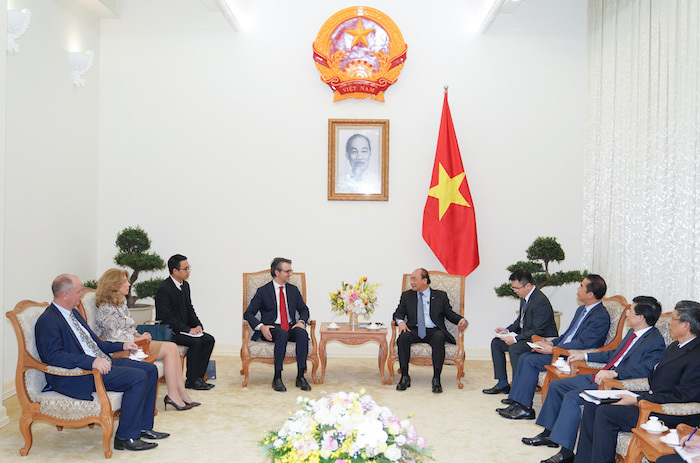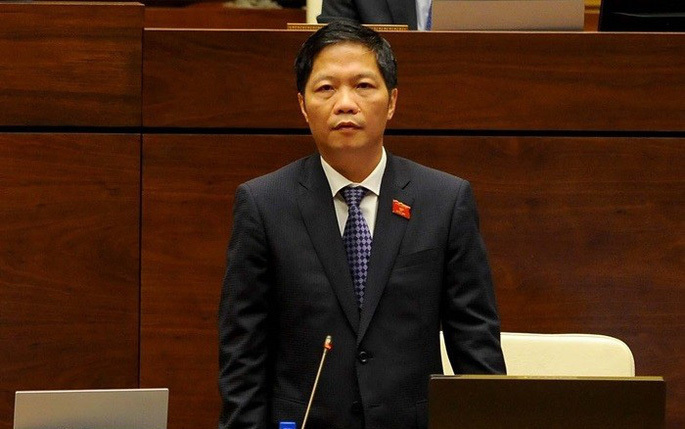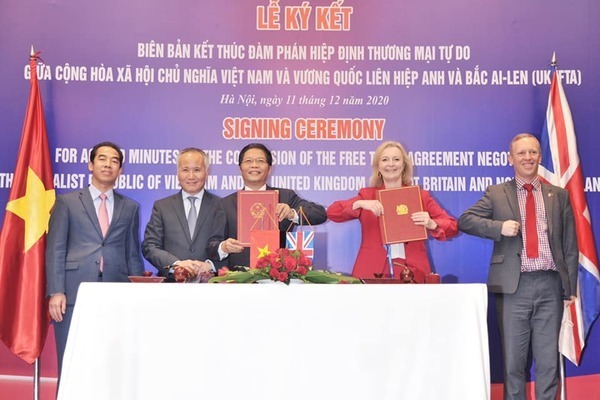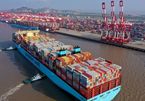Ambassador of the European Union (EU) to Vietnam Giorgio Aliberti adjusted his red tie, smiled and raised his hand to journalists at the headquarters of the EU delegation at Hanoi’s Lotte building. He had just left the meeting room of the Vietnamese National Assembly, where a few minutes earlier, on June 8, 2020 the Vietnam-EU Free Trade Agreement (EVFTA) was passed.
At the beginning of the press conference about that historic event, the Ambassador said: "I feel very lucky that Vietnam and the EU are at the stage of the best relations in history so far."
The EVFTA which came into effect on August 1 brought the import tax to 0% immediately for 71% of goods exported from Vietnam, and for 100% of goods in the next seven years.
The World Bank (WB) estimates that the EVFTA will help increase Vietnam's GDP growth by 2.4%; Vietnam's export growth by 12%; and help 800,000 people out of poverty.
 |
|
Prime Minister Nguyen Xuan Phuc receives Ambassador Giorgio Aliberti, Head of the EU delegation to Vietnam. Photo: VGP
|
The agreement was ratified by the European Parliament at the beginning of the year and by the Vietnamese National Assembly in the middle of this year. The negotiation process between the EU and Vietnam had dragged on nearly 10 years with many ups and downs.
The signing ceremony of EVFTA and the EU-Vietnam Investment Protection Agreement (EVIPA) took place on June 30 last year in Hanoi when Prime Minister Nguyen Xuan Phuc was attending the G20 Summit and paying an official visit to Japan. During the busy schedule, he flew back to Hanoi from Osaka to witness and speak at the signing ceremony and soon after, flew back to Japan within the day.
PM Phuc said: “These two important agreements will be like a large-scale, modern highway connecting the EU and Vietnam more closely."
“From here, people from both sides can easily cooperate and exchange, businesses of both sides can access each other's markets. In particular, EU businesses can access not only the market of nearly 100 million people of Vietnam but also the markets of ASEAN countries, the Comprehensive and Progressive Agreement for Trans-Pacific Partnership (CPTPP) and other major markets in East Asia, contributing to creating an impetus for East-West cooperation, and bringing prosperous development to Asia, Europe and the world,” he said.
Earlier, in mid-June 2019, Minister of Industry and Trade Tran Tuan Anh took a business trip to Europe to meet with the EU High Commissioner in charge of trade Cecilia Malmström and ministers of EU member states like Romania, Italy and Spain. Many difficult issues were raised in bilateral meetings as a condition to "finish" the two agreements.
Minister Tuan Anh, who used to work at the Ministry of Foreign Affairs, helped to resolve all those thorny problems, leading to the signing ceremony of the EVFTA.
"The EU has a foundation to place confidence in Vietnam's commitments in the agreement," he said.
World opens wide to welcome Vietnam
 |
|
Minister of Industry and Trade Tran Tuan Anh
|
The EVFTA has helped to create a common framework for Vietnam and the UK to conclude negotiations on the Vietnam-UK Free Trade Agreement (UKVFTA) on December 11. This agreement was initiated after Brexit and represents Vietnam-UK’s sharing of a common commitment to global trade, free flow of capital and investment.
This bilateral FTA provides an important continuation of the two sides' fast-growing, dynamic trade relationship.
Businesses can continue to benefit from reduced import and export taxes, enhanced access to service markets and protection of key products of Vietnam and the UK. This includes 65% of tariff lines that have been eliminated in bilateral trade.
This figure will increase to 99% after the end of the tariff reduction schedule. By the end of the roadmap, Vietnam will benefit by saving £114 million in taxes on exported products. For the UK’s exports, the corresponding figure would be £36 million.
In 2019, British businesses exported goods worth more than £600 million to Vietnam, while Vietnamese businesses exported goods to the UK worth about £4.6 billion.
Deputy Secretary General of the Vietnam Association of Seafood Exporters and Producers (VASEP) Nguyen Hoai Nam said that seafood exports to the UK will grow steadily 15-20% per year after the UKVFTA takes effect, from the current value of $280-300 million per year.
On November 15, under the witness of Prime Minister Nguyen Xuan Phuc and leaders of member countries, the Regional Comprehensive Economic Partnership (RCEP) was officially signed.
The RCEP with 15 member countries, and a GDP of nearly $27 trillion, can become the largest free trade area in the world, which is expected to promote the value chain and the economy of Vietnam. Minister Tuan Anh said the RCEP is an opportunity for Vietnamese businesses to expand their markets, boost exports, and participate in new value chains in the region and increase attraction of foreign investment.
"The reduction of import taxes will help products from prominent sectors such as telecommunications, information technology, textiles, footwear and agriculture of Vietnam have more opportunities to expand the market," he stressed.
It can be said that the year 2020, with the outbreak of the Covid-19 pandemic , which has adversely hit the world, was a successful year in the opening and integration of Vietnam. So far, Vietnam has had 13 effective FTAs in effect, including two new generation FTAs with extensive internal reform commitments, namely CPTPP and EVFTA. The other three FTAs are in the works.
 |
|
The signing ceremony of the conclusion of negotiations for the Vietnam-UK free trade agreement.
|
Vietnamese goods are everywhere
Minister Tuan Anh said that along with joining the WTO since 2007, the implementation of FTAs has contributed to boosting Vietnam's GDP by more than 300%, and import-export turnover by 350%. The import and export market has expanded and diversified; the financial services market is more developed with the participation of many foreign investors; the institutional and policy system has also been gradually completed to meet the requirements of integration and implementation of commitments in FTAs.
He said: “Vietnam's goods have reached almost all markets in the world. Many products have gradually gained a firm foothold and improved their competitiveness in many markets with high requirements for quality such as the EU, Japan, the US, Australia...".
Thanks to FTAs, exporting of Vietnamese goods to all five continents is very convenient to do. According to the Ministry of Industry and Trade, export revenues in January-November of 2020 were estimated to increase 5.5% over the same period last year. Vietnam broke a record trade surplus of nearly $20.16 billion during this period, much higher than the figure of $10.76 billion in the same period of 2019.
It is estimated that for the whole year, the total export and import turnover can reach over $500 billion, of which export turnover increases by about 4-5% over the same period in 2019. Vietnam is one of several countries in the world that have had impressive export growth in some sectors, even though global trade has been disrupted.
The EVFTA coming into effect on August 1 has created more room for import and export activities. In addition, some export markets have maintained good growth momentum such as China and the US. According to the US Department of Commerce, after many years as the largest exporter of apparel to the US, by June 2020, China ceded this position to Vietnam.
For the first time in decades, Vietnam accounts for over 20% of the apparel market share in the US, although in terms of total value, apparel exports in the first half of 2020 did not reach the level of 2019.
For the European market, Vietnam currently accounts for about 3% market share of textiles and footwear. However, it is expected that the EVFTA will help increase footwear exports by 50% and textiles by 67% by 2025, according to the Ministry of Planning and Investment.
Global bright spot: Vietnam
The World Trade Organization (WTO) in early October forecasted that global trade would drop 9.2% this year.
Previously, in August, WTO released a gloomy forecast, saying that global trade would decrease by 13-32% this year due to Covid-19 pandemic. The pandemic has affected countries in all aspects, breaking and global supply and value chains, and stalling production and business.
In that context, Vietnam's export growth is a bright spot. The result is a victory of a consistent and flexible international integration process. Besides, Vietnam has opened its doors, and in return, members of the 13 FTAs have also opened the door for Vietnam.
However, commitments to reform are needed due to integration pressures from new FTAs, the major driving force for changing the economy.
In January-November this year, 31 items had export turnover of over $1 billion, accounting for 92% of total export turnover. There were six export items worth over $10 billion, accounting for 64.3%, including: phones and components; electronics, computers and components; textiles; footwear; wood and wood products.
Tu Hoang - Lan Anh

Vietnam's economy to grow 6.8 percent in 2021: World Bank
Vietnam’s prospects appear positive as the economy is projected to grow by about 6.8 percent in 2021 and, thereafter, stabilise at around 6.5 percent, according to the latest World Bank’s economic update for Vietnam “Taking Stock”.

Vietnamese economy remains resilient despite COVID-19 challenges
The Vietnamese economy has remained extremely resilient throughout the year despite the adverse impact of COVID-19 pandemic, with import-export activities witnessing a gradual bounce back, according to insiders.